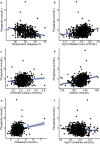Clinical and laboratory features associated with serum phosphate concentrations in malaria and other febrile illnesses
- PMID: 32085712
- PMCID: PMC7035648
- DOI: 10.1186/s12936-020-03166-z
Clinical and laboratory features associated with serum phosphate concentrations in malaria and other febrile illnesses
Abstract
Background: Hypophosphatemia is common in severe infections including malaria. Previous studies suggested that serum phosphate concentrations correlate with temperature, but it is unclear whether the type of infection and other factors occurring during infection influence this association. Here relationships were investigated between serum phosphate levels, cause of fever, demographic, clinical and laboratory parameters.
Methods: Anonymized data were analysed from 633 adults with malaria or other febrile illness admitted to Northwick Park Hospital, London, UK. Univariable and multivariable generalized linear model analyses were performed to examine associations with serum phosphate levels. Interaction terms were included to investigate whether cause of fever (malaria vs other illness), malaria parasite species, or malaria severity influenced the association of other variables with phosphate.
Results: Hypophosphatemia was common in subjects with malaria (211/542 (39%)), and in other febrile illnesses (24/91 (26%)), however median phosphate levels did not differ significantly by diagnostic group, parasite species or severity of malaria. In all analyses, there were highly significant negative associations between serum phosphate and axillary temperature, and positive associations between serum phosphate and platelet count. There were no significant interactions between these variables and cause of fever, parasite species or severity of illness. Sodium and potassium concentrations were associated with serum phosphate in subjects with malaria and when data from all subjects was combined.
Conclusion: Serum phosphate is consistently associated with temperature and platelet count in adults with diverse causes of fever. This may be a consequence of phosphate shifts from plasma into cells to support ATP generation for thermogenesis and platelet activation.
Keywords: Hypophosphatemia; Infection; Malaria; Phosphate; Platelets; Temperature.
Conflict of interest statement
The authors declare that they have no competing interests.
Figures

Similar articles
-
Serum ionized calcium, serum and intracellular phosphate, and serum parathormone concentrations in acute malaria.Trans R Soc Trop Med Hyg. 1993 Jan-Feb;87(1):49-53. doi: 10.1016/0035-9203(93)90416-n. Trans R Soc Trop Med Hyg. 1993. PMID: 8465394
-
UK malaria treatment guidelines 2016.J Infect. 2016 Jun;72(6):635-649. doi: 10.1016/j.jinf.2016.02.001. Epub 2016 Feb 12. J Infect. 2016. PMID: 26880088 Free PMC article.
-
Folic acid supplementation and malaria susceptibility and severity among people taking antifolate antimalarial drugs in endemic areas.Cochrane Database Syst Rev. 2022 Feb 1;2(2022):CD014217. doi: 10.1002/14651858.CD014217. Cochrane Database Syst Rev. 2022. PMID: 36321557 Free PMC article.
-
Can hematological parameters discriminate malaria from nonmalarious acute febrile illness in the tropics?Indian J Med Sci. 2004 Jun;58(6):239-44. Indian J Med Sci. 2004. PMID: 15226575
-
The role of cytokines in Plasmodium vivax malaria.Mem Inst Oswaldo Cruz. 1992;87 Suppl 3:51-5. doi: 10.1590/s0074-02761992000700006. Mem Inst Oswaldo Cruz. 1992. PMID: 1343726 Review.
Cited by
-
Enzyme Immobilization by Inkjet Printing on Reagentless Biosensors for Electrochemical Phosphate Detection.Biosensors (Basel). 2024 Mar 30;14(4):168. doi: 10.3390/bios14040168. Biosensors (Basel). 2024. PMID: 38667161 Free PMC article.
-
Non-canonical metabolic pathways in the malaria parasite detected by isotope-tracing metabolomics.Mol Syst Biol. 2021 Apr;17(4):e10023. doi: 10.15252/msb.202010023. Mol Syst Biol. 2021. PMID: 33821563 Free PMC article.
-
Mitochondrial ion channels in cardiac function.Am J Physiol Cell Physiol. 2021 Nov 1;321(5):C812-C825. doi: 10.1152/ajpcell.00246.2021. Epub 2021 Sep 22. Am J Physiol Cell Physiol. 2021. PMID: 34550794 Free PMC article. Review.
-
Association between serum phosphate and mortality in critically ill patients: a large retrospective cohort study.BMJ Open. 2021 Sep 6;11(9):e044473. doi: 10.1136/bmjopen-2020-044473. BMJ Open. 2021. PMID: 34489265 Free PMC article.
References
-
- Shor R, Halabe A, Rishver S, Tilis Y, Matas Z, Fux A, et al. Severe hypophosphatemia in sepsis as a mortality predictor. Ann Clin Lab Sci. 2006;36:67–72. - PubMed
MeSH terms
Substances
Grants and funding
LinkOut - more resources
Full Text Sources

